
Travel Guide
Nagoya Castle is very much the symbol of Nagoya, and it is one of the top three castles in Japan. For over 350 years, it was the biggest, the best designed, the most gorgeous and well preserved of all the castles in Japan. There’s more than just the big castle. Stroll the beautiful gardens and enjoy the seasonal flowers and blossom, try a traditional beverage in the tea rooms, hunt for crests engraved on the stone walls or just lap up the history at Japan’s biggest castle. Nagoya Castle hosts events throughout the year. The summer festival in August, maple leaf celebrations in November, and a New Year countdown celebration are all highlights of the local calendar. Nagoya Castle remains a proud symbol of the city, one you’ll be proud to have visited, and it is certainly worth a visit especially during cherry blossom season. The castle was the first castle structure in Japan to be designated as a National Treasure in 1930.
Nagoya Castle was built in 1615 as the seat of one of the three branches of the ruling Tokugawa family, the Owari branch. As such, it was one of the largest castles in the country, and the castle town around it ultimately grew to become Japan's fourth largest city.
During the Edo period, Nagoya Castle was the heart of one of the most important castle towns in Japan, Nagoya-juku, which was a post station on the Minoji road linking two of five important trade routes, the Tokaido and the Nakasendo. Another way of pronouncing Nagoya Castle is Meijo. This name is used for many city institutions, such as Meijo Park, the metro's Meijo Line and Meijo University, reflecting the cultural influence of this historic structure.
Most original castle buildings burned down in air raids during World War Two, including the castle keep and the palace buildings, but the reconstructed version is no less impressive.
The current ferro-concrete reconstruction of the castle keep dates from 1959 and - before its closure in May 2018 - contained a modern museum with exhibits about the castle's history. Topped with two meter tall 18 Karat golden dolphin like shachi ornaments, Nagoya Castle was the nations biggest keep. It has more karahafu, the triangular shaped roof features than any other Japanese castle, and interestingly featured two keeps, a smaller keep linked via a high walled, open topped walkway to the magnificent main keep. Browse the fascinating historical exhibits inside the castle keep, which depict life-size representations of how life was within the castle walls, along with models of the castle, and artifacts that survived the blaze. From the top floor of the keep, look out across the city and imagine how different it would have been for the powerful daimyo samurai chiefs when they surveyed the same land.
Adjoining the castle to the north is Meijo Park. The park surrounding the castle keep features two circles of moats and impressive walls with corner turrets. While one part of the castle grounds, today this beautiful park boasts flower beds, a fish pond, and a windmill, and is popular year-round with croquet players, joggers, and young couples. The park becomes an attractive hanami spot during the cherry blossom season which usually peaks in late March or early April.
The castle's palace (Honmaru Goten) was recently rebuilt and fully opened to the public in June 2018. It took a total of 10 years to complete the construction. The palace was reconstructed just as it was before, including all decorations. This was possible because the detailed records of the building were taken before the World War Two. This one-story wooden building used to be the residence of the lord of Nagoya and the place where he would receive visitors. Half a century after its destruction in the war, the palace was rebuilt using traditional construction materials and techniques. It contains entrance and reception halls as well as rooms reserved for the visiting shogun with beautiful, replicated paintings on the sliding doors (fusuma). You can also marvel at the beauty of the golden wall paintings depicting the seasons and other motives found in nature and folklore. The intricate carvings are another awe-inspiring sight. The palace has been considered one of the finest examples of Shoin architecture in all of Japan.
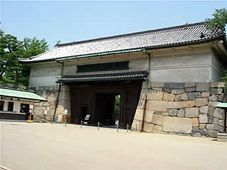 |
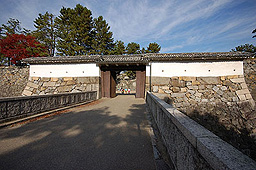 |
| Main entrance | East gate |
In 1600 Japan was finally united after a long period of war between east and west. The west had won and established its capital in Tokyo, then called Edo. The defeated forces, strongest around Osaka, returned home. It wasn’t sure how stable the newfound peace would be and so the new leader of Japan, Tokugawa Ieyasu, decided to be safe than sorry and commissioned the construction of a castle in Nagoya as an effective defense line against his enemies in Osaka.
The biggest town in the region was Kiyosu, but from a strategic standpoint, the area around 8 kilometers south of it was better suited for a big castle. And so the whole town of Kiyosu was moved in 1612 in an operation now known as Kiyosu Goshi or the move of Kiyosu. Not only the people but also temples, shrines, bridges and other important buildings were relocated to the newly founded city called Nagoya.
Tokugawa put one of his sons in charge of the region. This son became the first lord of the Owari region with Nagoya as its main city. The lord of Owari lived at Nagoya Castle and was not only in charge of the cities defense but also its development.
The arts including tea ceremony and Noh theater blossomed and fine ceramics were produced in the Owari region.
For the next 260 years, the castle and in extension the city thrived as the seat of the Owari Tokugawa clan. It was peace in Japan and the castle was never under siege.
It’s strategic location between Osaka and Edo also meant many travelers came through, which was great for the overall economy and development of the city which made it one of the most prosperous during the Edo Period.
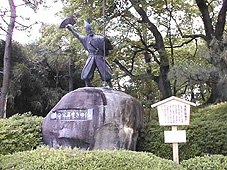 |
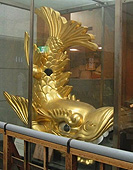 |
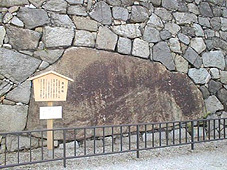 |
| Statue of Kato Kiyomasa | Golden shachi | Kiyomasa Stone |
Travel Advice
Sightseeing
Since 2019 a new reconstruction project was started that will see the iconic keep with its white walls and metallic green roofs restored to its original authentic beauty. A date for the completion of the project hasn’t been set yet. Since the keep is currently under reconstruction and it is not possible to enter now.
Tips about Nagoya Castle
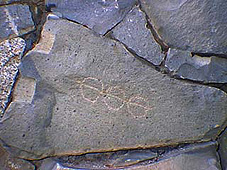 - Two sets of walls surround the castle, an outer and an inner wall, two important defenses against approaching enemies.
- Two sets of walls surround the castle, an outer and an inner wall, two important defenses against approaching enemies.
- The wily Tokugawa Ieyasu ensued that the most splendid castle was built at next to no personal cost. Instead, he ordered the nations daimyo, the nobility to supply stones for the walls, timbers for the buildings, and great numbers of laborers to complete the massive construction. Sourcing and transporting the many tons of huge stones and construction materials, not to mention timber, and labor costs put considerable financial strain on the various nobles. A strain that prevented them spending on arms, armor and armies, thus lessening any potential for insurrection.
- Any daimyo refusing to comply would be destroyed, and in an effort to show compliance, many would carve a crest in the stones they supplied to prove their allegiance. These crests can still be seen along the stone walls and makes for an enjoyable side attraction of trying to find them, and looking at the many varied marks made. One of the biggest rocks used in the walls is known as the Kiyomasa Stone after the samurai architect, Kato Kiyomasa, who was enlisted to use his considerable castle building skills to make Nagoya one of the most impeneterible fortresses in Japan. His statue can also be seen standing atop a large stone, as he was said to have done when encouraging the workers.
- There are two golden shachi on either end of the topmost castle roof. A beast from Japanese mythology, shachi are tiger-headed dolphins or carp considered to have control over the rain. As such, they were employed in traditional Japanese architecture as a talisman to prevent fires. They first appeared in the Muromachi Era (1334–1400) and also served as a symbol of the lord's authority.
- Japanese people will think of Nagoya Castle when they talk about shachi, but first castle where shachiwas placed on castle keep was Azuchi Castle built by Oda Nobunaga. In addition to Azuchi Castle, the castle keep of Toyotomi Hideyoshi's Osaka Castle and Edo Castle are all equipped with shachi.
- The original shachi were formed over a roughly carved block of wood, over which lead sheets were applied. Copper was placed over the lead before the application of the final layer of gold, which was produced by pounding gold coins into thin sheets. It is said that the gold used amounted to a value of 17,975 ryō (taels), when converted from Keicho-period coins. The core of the golden shachi is composed of hinoki cypress; originally the foundation was sawara cypress.
- The golden shachi were melted down and recast three times during the Edo period, when the Owari branch suffered severe economic hardship. When the shachi were recast in Bunsei 10 (1827), the purity of the gold was greatly decreased. In order to conceal the diminished luster, openings in the mesh in the protective bird screens built around the shachi were made smaller during the Kyōho period (1715–1735).
- The shachi were destroyed by fire during World War II. The second-generation golden shachi were cast in the Osaka Mint and transported to the castle in March 1959 (Shōwa 39). Both kinshachi were lowered temporarily from atop the castle and displayed on the castle grounds briefly in September 1984 (Shōwa 59) for the Nagoya Castle Exhibition, and again from March 19 to June 19, 2005 (Heisei 17), at the site of the Expo 2005. They were restored to the top beam of the castle roof on July 9 of the same year.
Toor Guide
| Japanese guide | ||
| Service | Volunteer guides to guide you on your tour around the castle grounds and give you lots of interesting information on the history of Nagoya, and the castle. | |
| Contact | TEL 052-231-1700(Nagoya Castle Office) | |
| Reception | Main entrance and Gate east | |
| Fee | Free | |
| Hours | Every weekday at 10:00 / 13:30 and weekend at 9:30 / 11:00 / 13:30 | |
| Language | Japanese | |
| Time | 1 to 1 and half hour | |
| English guide | ||
| Service | NPO Aichi Goodwill Guides Network to guide you on your tour around the castle grounds and give you lots of interesting information on the history of Nagoya, and the castle. | |
| Contact | TEL 0561-75-6977(NPO Aichi Goodwill Guides Network) | |
| Reception | Main entrance and Gate east | |
| Fee | Free | |
| Hours | every day at 13:00 | |
| Language | English | |
| Time | 1 hour | |
Facilities
- Free rental for wheelchairs are provided.
Visit
| Address | 1-1 Honmaru, Naka-ku, Nagoya-shi, Aichi | |
| Phone | 052-231-1700(Nagoya Castle Office) | |
| Admission | Nagoya Castle Adult: 500 yen Package for Catle keep and Tokugawaen Garden Adult: 640 yen |
Adult: over 15 Group tickets are available |
| Hours | 09:00 to 16:30 | |
| Closed | December 29 to January 1 | |
| Duration | 30 minutes | |
| Getting There | By Train 5 minute walk from Shiyakusyo Station on subway Meijo Line. 15 minute walk from Asamacho Station on subway Tsurumai Line. 15 minute walk from Higashiote Park Station on Seto Line of Nagoya Raiway. By Bus 1 minute walk from Nagoyajo Seimonmae bus stop city bus. 5 minute walk from Shiyakusyo bus stop on city bus or Nagoya bus. By Car Take Nagoya Expressway to the Marunouchi exit. It is approximately 1 kilometers 15 minutes from exit. |
|
| Parking | Pay parking available | |

